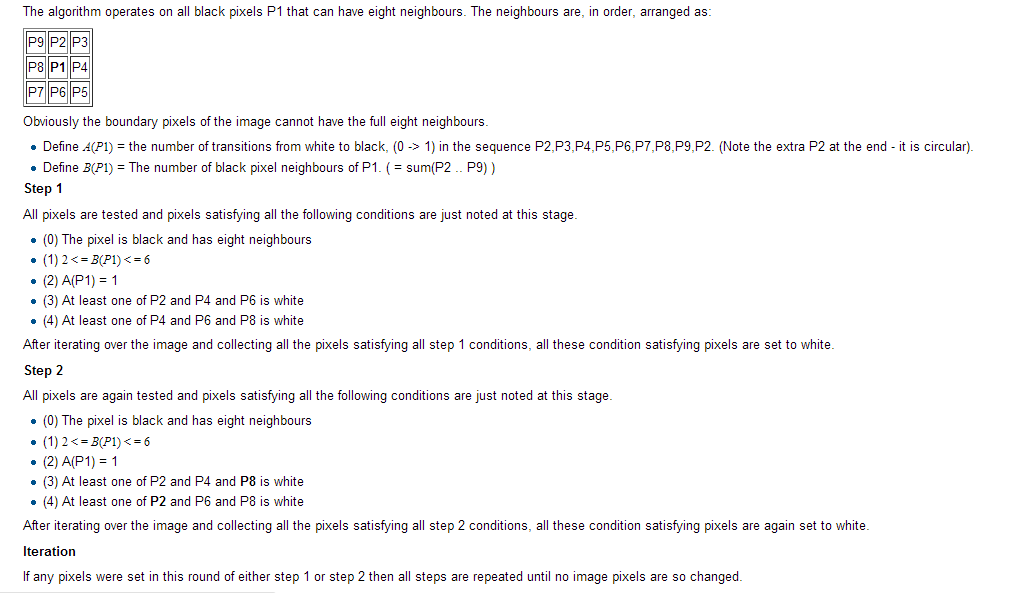我正在尝试按照此指南在 C# 中编写 Zhang-Suen 细化算法,而不处理边距。

在“zhangsuen”函数中,我正在读取图像“imgUndo”并写入图像“img”。 for 循环中的指针 dataPtrOrigin_aux 用于读取 3x3 窗口内的 9 个像素,使得 dataPtrOrigin_aux5 是该窗口的中心像素,并且该窗口将沿着整个图像移动,从左到右,从上到下移动。在每个像素中,如果if语句被验证为真,则对指针dataPtrFinal要写入的图像进行相应的更改。
请注意,我将当前像素的邻居存储在一个 8 元素数组中。因此,它们将按照以下顺序存储:

internal static void zhangsuen(Image<Bgr, byte> img, Image<Bgr, byte> imgUndo)
{
unsafe
{
MIplImage m = img.MIplImage; //Image to be written.
MIplImage mUndo = imgUndo.MIplImage; //Image to be read.
byte* dataPtrFinal = (byte*)m.imageData.ToPointer();
byte* dataPtrUndo = (byte*)mUndo.imageData.ToPointer();
int width = img.Width; //Width of the image.
int height = img.Height; //Height of the image.
int nChan = m.nChannels; //3 channels (R, G, B).
int wStep = m.widthStep; //Total width of the image (including padding).
int padding = wStep - nChan * width; //Padding at the end of each line.
int x, y, i;
int[] neighbours = new int[8]; //Store the value of the surrounding neighbours in this array.
int step; //Step 1 or 2.
int[] sequence = { 1, 2, 4, 7, 6, 5, 3, 0, 1 };
int blackn = 0; //Number of black neighbours.
int numtransitions = 0; //Number of transitions from white to black in the sequence specified by the array sequence.
int changed = 1; //Just so it enters the while.
bool isblack = false;
int counter = 0;
while(changed > 0)
{
changed = 0;
if (counter % 2 == 0) //We want to read all the pixels in the image before going to the next step
step = 1;
else
step = 2;
for (y = 0; y < height; y++)
{
for (x = 0; x < width; x++)
{
byte* dataPtrOrigin_aux1 = (byte*)(dataPtrUndo + (y - 1) * m.widthStep + (x - 1) * m.nChannels);
byte* dataPtrOrigin_aux2 = (byte*)(dataPtrUndo + (y - 1) * m.widthStep + (x) * m.nChannels);
byte* dataPtrOrigin_aux3 = (byte*)(dataPtrUndo + (y - 1) * m.widthStep + (x + 1) * m.nChannels);
byte* dataPtrOrigin_aux4 = (byte*)(dataPtrUndo + (y) * m.widthStep + (x - 1) * m.nChannels);
byte* dataPtrOrigin_aux5 = (byte*)(dataPtrUndo + (y) * m.widthStep + (x) * m.nChannels);
byte* dataPtrOrigin_aux6 = (byte*)(dataPtrUndo + (y) * m.widthStep + (x + 1) * m.nChannels);
byte* dataPtrOrigin_aux7 = (byte*)(dataPtrUndo + (y + 1) * m.widthStep + (x - 1) * m.nChannels);
byte* dataPtrOrigin_aux8 = (byte*)(dataPtrUndo + (y + 1) * m.widthStep + (x) * m.nChannels);
byte* dataPtrOrigin_aux9 = (byte*)(dataPtrUndo + (y + 1) * m.widthStep + (x + 1) * m.nChannels);
if (x > 0 && y > 0 && x < width - 1 && y < height - 1)
{
if (dataPtrOrigin_aux5[0] == 0)
isblack = true;
if (isblack)
{
neighbours[0] = dataPtrOrigin_aux1[0];
neighbours[1] = dataPtrOrigin_aux2[0];
neighbours[2] = dataPtrOrigin_aux3[0];
neighbours[3] = dataPtrOrigin_aux4[0];
neighbours[4] = dataPtrOrigin_aux6[0];
neighbours[5] = dataPtrOrigin_aux7[0];
neighbours[6] = dataPtrOrigin_aux8[0];
neighbours[7] = dataPtrOrigin_aux9[0];
for(i = 0; i <= 7; i++)
{
if (neighbours[i] == 0)
blackn++;
if (neighbours[sequence[i]] - neighbours[sequence[i + 1]] == 255) //número de transições de branco para preto, seguindo a ordem do vector sequence
numtransitions++;
}
if ((blackn >= 2 && blackn <= 6) && numtransitions == 1)
{
if (step == 1 && (neighbours[1] == 255 || neighbours[4] == 255 || neighbours[6] == 255) && (neighbours[4] == 255 || neighbours[6] == 255 || neighbours[3] == 255))
{
dataPtrFinal[0] = 255;
dataPtrFinal[1] = 255;
dataPtrFinal[2] = 255;
changed++;
}
if (step == 2 && (neighbours[1] == 255 || neighbours[4] == 255 || neighbours[3] == 255) && (neighbours[1] == 255 || neighbours[6] == 255 || neighbours[3] == 255))
{
dataPtrFinal[0] = 255;
dataPtrFinal[1] = 255;
dataPtrFinal[2] = 255;
changed++;
}
}
}
}
dataPtrFinal += nChan;
isblack = false;
blackn = 0;
numtransitions = 0;
}
dataPtrFinal += padding;
}
dataPtrUndo = (byte*)m.imageData.ToPointer(); //Change the image to be read to the one that has just been written.
counter++;
}
}
}
当我结束读取第一张图像并将更改写入图像“img”时(一旦 (y = 0; y < height; y++) 的循环结束,我希望我刚刚写入的图像成为我将在下一个周期中阅读,以便进一步细化。我试图用这条线来完成这一点
dataPtrUndo = (byte*)m.imageData.ToPointer();
虽然计数器的某个值大于 0(取决于读取的图像),但我收到一条错误消息,指出已尝试写入 protected 内存,这表明我已尝试在图像限制之外写入,但我不明白为什么。它是我错误地做的最后归因于 dataPtrUndo 吗?
最佳答案
这是我对 Zhang-Suen 细化算法的 C# 实现
public static bool[][] ZhangSuenThinning(bool[][] s)
{
bool[][] temp = s;
bool even = true;
for (int a = 1; a < s.Length-1; a++)
{
for (int b = 1; b < s[0].Length-1; b++)
{
if (SuenThinningAlg(a, b, temp, even))
{
temp[a][b] = false;
}
even = !even;
}
}
return temp;
}
static bool SuenThinningAlg(int x, int y, bool[][] s, bool even)
{
bool p2 = s[x][y - 1];
bool p3 = s[x + 1][y - 1];
bool p4 = s[x + 1][y];
bool p5 = s[x + 1][y + 1];
bool p6 = s[x][y + 1];
bool p7 = s[x - 1][y + 1];
bool p8 = s[x - 1][y];
bool p9 = s[x - 1][y - 1];
int bp1 = NumberOfNonZeroNeighbors(x, y, s);
if (bp1 >= 2 && bp1 <= 6)//2nd condition
{
if (NumberOfZeroToOneTransitionFromP9(x, y, s) == 1)
{
if (even)
{
if (!((p2 && p4) && p8))
{
if (!((p2 && p6) && p8))
{
return true;
}
}
}
else
{
if (!((p2 && p4) && p6))
{
if (!((p4 && p6) && p8))
{
return true;
}
}
}
}
}
return false;
}
static int NumberOfZeroToOneTransitionFromP9(int x, int y, bool[][]s)
{
bool p2 = s[x][y - 1];
bool p3 = s[x + 1][y - 1];
bool p4 = s[x + 1][y];
bool p5 = s[x + 1][y + 1];
bool p6 = s[x][y + 1];
bool p7 = s[x - 1][y + 1];
bool p8 = s[x - 1][y];
bool p9 = s[x - 1][y - 1];
int A = Convert.ToInt32((p2 == false && p3 == true)) + Convert.ToInt32((p3 == false && p4 == true)) +
Convert.ToInt32((p4 == false && p5 == true)) + Convert.ToInt32((p5 == false && p6 == true)) +
Convert.ToInt32((p6 == false && p7 == true)) + Convert.ToInt32((p7 == false && p8 == true)) +
Convert.ToInt32((p8 == false && p9 == true)) + Convert.ToInt32((p9 == false && p2 == true));
return A;
}
static int NumberOfNonZeroNeighbors(int x, int y, bool[][]s)
{
int count = 0;
if (s[x-1][y])
count++;
if (s[x-1][y+1])
count++;
if (s[x-1][y-1])
count++;
if (s[x][y+1])
count++;
if (s[x][y-1])
count++;
if (s[x+1][y])
count++;
if (s[x+1][y+1])
count++;
if (s[x+1][y-1])
count++;
return count;
}
关于c# - Zhang-Suen细化算法C#,我们在Stack Overflow上找到一个类似的问题: https://stackoverflow.com/questions/20245003/